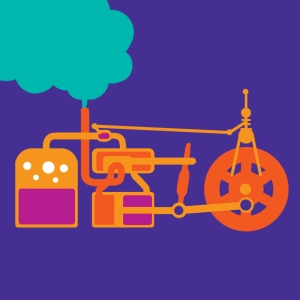 Steam engine
Steam engine
As its name suggests, the steam engine operates on the force of water vapor (steam) heated to high pressure. It is a technology that converts thermal energy (heat) to mechanical energy (work).
The boiler heats the water turning it to steam. The pressure generated is then used to drive a piston within a cylinder. The piston is attached to a connecting rod for transforming the translational movement into a rotational movement.
The animation above shows the steam engine of the Scottish inventor, James Watt. It has many improvements over its predecessors machines (Somerset, Papin, Savery, Newcomen). He invented, in 1782, the principle of the double effect machine (or double action) in which a sliding valve distributing the pressure on the piston is driven in both directions.
The centrifugal regulator (rotating balls) is another innovation introduced by James Watt (1788). It maintains an almost constant rate despite fluctuations in available pressure.
Click and drag the slider to increase or decrease the temperature.
